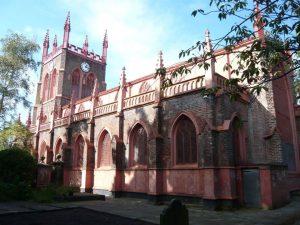John Cragg
The production of industrial equipment in Liverpool for use by enslaved people on the plantations of the Americas provided the finance for the development of some of the town’s most architecturally important buildings and one of its most salubrious suburbs. John Cragg (1767-1854), the renowned Liverpool church builder was the owner of the Mersey Iron Foundry in Tithebarn Street, yet his fortune was not made through the building of iron churches. According to his friend, inventor and engineering great, James Nasmyth, it was Cragg’s ‘extensive manufacture of large sugar-boiling pans’ used on the slave plantations of the West Indies that provided the wealth needed to allow him to indulge his passion for innovations in ecclesiastical architecture. His reliance on wealth generated from the slavers of the Caribbean led to Cragg joining the port’s absentee plantation owners as a member of the Liverpool West India Association. The Association would fight tooth and nail to prevent the abolition of slavery in Britain’s colonies and its members were instrumental in ensuring that 20 million pounds compensation was paid to the slave-owners when slavery was finally abolished in 1834.

Along with his innovative places of worship, Cragg also played a part in the introduction of iron as a building material in domestic settings. He built six of the earliest houses to be erected at Saint Michael’s in the Hamlet incorporating many features made of cast iron into the buildings, contributing to the suburb’s quaint character and culminating in the area leading down to the Mersey becoming known locally as ‘the Cast Iron Shore’. Cragg owned a house in the hamlet he named ‘Hollybank’, used as his country retreat, whilst also owning a house at St James Walk, the site of which is now incorporated into the Anglican Cathedral estate. Cragg’s churches are of such architectural and historical importance that the two surviving examples, St George’s, Everton (consecrated 1814) and St Michael’s in the Hamlet, Aigburth (1815), are both grade I listed. The third, St Phillip’s (1816), stood on Hardman Street and was partially demolished in 1884, the surviving portions incorporated into the Victorian building that stood on the site until 2017. All three churches had graveyards attached and some of Liverpool’s most prominent slave merchants were buried in the precincts of the respective churches. John Cragg died in 1854, and was buried in St. James’s Cemetery, near to his home on St. James’s Walk.



John Cragg was an investor in the Royal Institution and owned one share.